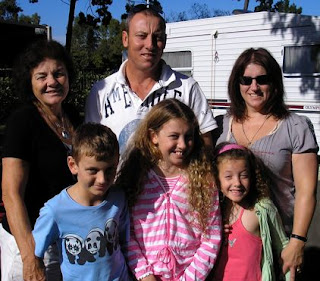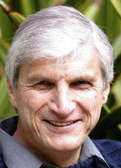
Just two days after the winter solstice, we find ourselves in Townsville, where the noon temperature is 27 deg.
Air force jets and helicopters from nearby Garbutt base make it a noisy spot.
And it will get noisier as our park is next to the showgrounds where the local annual show is about to commence.

But we are happy to be located close to the CBD. And Carol is happy to put behind her the green frog incident, mentioned later in these notes.
Views from the top of Castle Hill to west Townsville (above right) where our van park is in about the middle of the picture, and (right) Magnetic Island to the northeast.
Carol immediately called our good friend Col Gellatly’s daughter Kristy who is here while her husband serves with the Australian Defence Force in East Timor.
Kristy and her four delightful children Lachlan, Isabelle, Georgia and Sophie came around for a slap-up meal of Home Hill sausages and eggs.
Above right: Carol with Kristy and her four cherubs.They’re off shortly to celebrate Col’s 60th birthday at Shoal Bay in Port Stephens, which unfortunately we will miss.
Next day Carol reconnected with her cousin Margaret Anstey (nee Besant) whom I haven’t seen in 45 years and Carol has seen only once in that time, after fate took us on different paths.
Here’s the relationship: Carol’s grandfather Pop Dossetto and Margaret’s grandmother Margaret Mary were brother and sister.
We had a lot to talk about, particularly as both Carol and Margaret have daughters in the Middle East, our Sue in Dubai and her Tiffany in Jeddah, where she is a flight attendant.

Carol then took time out with Margaret to visit Margaret’s mother Rene Besant at her nursing home. As Rene and Carol’s deceased mother Lorraine were very close, it was an emotional time.
Margaret Anstey and Carol -- their second meeting in 45 years.Bowen: back to the ‘50sThis has been an interesting journey into the tropics.
Our first stop after Airlie Beach was Bowen, the top end of the Whitsunday Coast, which was like revisiting the 1950s.
There are no traffic lights, no high-rise buildings and the pubs are colonial in character.

The streets are so wide that with even with angle parking there are four clear traffic lanes plus a generous median strip.
Right: downtown Bowen.
Carol reckons you need to take a cut lunch to cross the road. No-one likes to walk too far: there are more corner pubs and bottle shops within a half kilometre square here than in any town I’ve seen.
Right: Bowen port and marina.Old-timers say that during World War II amphibious Catalina aircraf

t used to land in the main street. You can see why Baz Lurhmann chose to film a chunk of
'Australia' the movie here.
For us it was like returning to the lazy crazy days of summer in Brisbane.
Right: off Bowen, impressive Gloucester Island.Bowen’s beaches feature the obligatory coconut trees, signs warning about stingers, and racks with large bottles of vinegar strategically positioned for use ‘in case’ by those brave or foolhardy enough to take a dip.
Our caravan park is appropriately named Wangaratta, as most of the inmates are Victorians escaping the cold. The pub across the road serves VB and Carlton Draught on tap, but not Fourex Bitter, can you believe!

Here we were appalled to find three year olds straying from the bistro area to play the poker machines (under their parents guidance, I might add!).
At our park, old school buses decorated with pot plants are home to permanent residents. ‘Bluey’, aged 84, who still works as a tomato picker, was happy to supply us with a super fresh bag for twenty cents. And a young mum with three kids in a bus next door did the same with cucumbers.

Interesting place.
Above right: Carol at golf in Proserpine and (right) on the 18th green, Bowen.Simon, sugar and steaksWe pushed on through Home Hill and endless sugar cane farms to Ayr, a very lively town in stark contrast to sleepy Bowen.
There we caught up with my cousin Simon Williams. Our rig looked resplendent among the cane, parked outside his house.
Simon, who used to run his own earthmoving equipment business, has 130 acres of cane under cultivation at a farm he bought freehold just a few kilometres out of town.
We hadn’t seen him since his mother Eve (my Dad’s sister) died three years ago so we had a lot to talk about.
He’s a hard worker. To build equity he’s also driving heavy machinery at a coal mine 360 kilometres west, working four days on with four days off. That’s commitment!

His hard work will be rewarded as sugar prices have racheted up and he’ll soon be able to give away the mine work.
Right: Simon and I check his cane crop.That night we dined on the biggest steaks we’ve seen, washed down with copious amounts of beer.
A frog went a courtin’ in a toilet bowl, aha!Carol will hate me for this but I have to tell the story about the green frogs.
When we arrived she asked to use the toilet. After a few moments there was a loud shriek and out she came white as a sheet. “There’s a frog in the toilet!” she said.
Simon, being a batchelor, seemed unfazed but obviously I had to check it out.
With a hand gloved in a plastic bag and aided by the flush, I discovered that not one but four green frogs had made their home under the rim of the toilet where it was obviously cool and the occasional flush simulated a waterfall, a perfect spot if you’re a green frog.
But for a human, the sight of a little green head peering up between your naked thighs can be disconcerting.
After extracting each frog one by one (they were not happy to leave) and throwing it out the window, I gave Carol the ‘all clear’ to use the loo.
“NO WAY!” she said and headed for the van toilet, out of bounds to green frogs.
Here in Townsville we plan to be out and about, with visits to Charters Towers and Magnetic Island. We’ll keep you posted.









 bombing raids on Townsville, a major military base, in 1942. But judging by the amount of damage inflicted, they may as well have been water
bombing raids on Townsville, a major military base, in 1942. But judging by the amount of damage inflicted, they may as well have been water  bombing.
bombing.
 ,” said the owner, Ken. “We sold up and spend our lives travelling around Queensland.”
,” said the owner, Ken. “We sold up and spend our lives travelling around Queensland.”








































